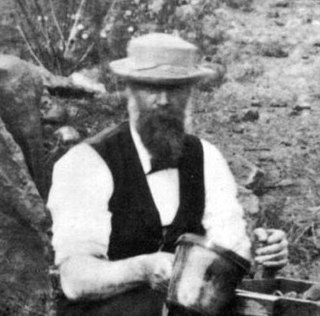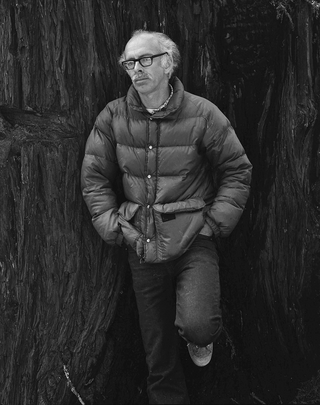
Ansel Easton Adams was an American landscape photographer and environmentalist known for his black-and-white images of the American West. He helped found Group f/64, an association of photographers advocating "pure" photography which favored sharp focus and the use of the full tonal range of a photograph. He and Fred Archer developed a system of image-making called the Zone System, a method of achieving a desired final print through a technical understanding of how the tonal range of an image is the result of choices made in exposure, negative development, and printing.

Carleton E. Watkins (1829–1916) was an American photographer of the 19th century. Born in New York, he moved to California and quickly became interested in photography. He focused mainly on landscape photography, and Yosemite Valley was a favorite subject of his. His photographs of the valley significantly influenced the United States Congress' decision to preserve it as a National Park.
Frederick Sommer, was an artist born in Angri, Italy and raised in Brazil. He earned a M.A. degree in Landscape Architecture (1927) from Cornell University where he met Frances Elisabeth Watson (1904–1999) whom he married in 1928; they had no children. The Sommers moved to Tucson, Arizona in 1931 and then Prescott, Arizona in 1935. Sommer became a naturalized citizen of the United States on November 18, 1939.

The Amon Carter Museum of American Art is located in Fort Worth, Texas, in the city's cultural district. The museum's permanent collection features paintings, photography, sculpture, and works on paper by leading artists working in the United States and its North American territories in the nineteenth and twentieth centuries. The greatest concentration of works falls into the period from the 1820s through the 1940s. Photographs, prints, and other works on paper produced up to the present day are also an area of strength in the museum's holdings.

Eliot Furness Porter was an American photographer best known for his color photographs of nature.
Judith Rose Dater is an American photographer and feminist. She is celebrated for her 1974 photograph, Imogen and Twinka at Yosemite, featuring an elderly Imogen Cunningham, one of America's first woman photographers, encountering a nymph in the woods of Yosemite. The nymph is the model Twinka Thiebaud. The photo was published in Life magazine in its 1976 issue about the first 200 years of American women. Her photographs, such as her Self-Portraiture sequence, were also exhibited in the Getty Museum.

Moonrise, Hernandez, New Mexico is a black-and-white photograph taken by Ansel Adams, late in the afternoon on November 1, 1941, from a shoulder of highway US 84 / US 285 in the unincorporated community of Hernandez, New Mexico. The photograph shows the Moon rising in a dominating black sky above a collection of modest dwellings, a church and a cross-filled graveyard, with snow-covered mountains in the background. Adams captured a single image, with the sunset lighting the white crosses and buildings. Because Adams did not date the image, attempts have been made to determine a date from astronomical information in the photograph. It is one of Adams' most popular works.
Rondal Partridge was an American photographer. After working as an assistant to well-known photographers Dorothea Lange and Ansel Adams in his youth, he went on to a long career as a photographer and filmmaker.
Anthony Hernandez is an American photographer who divides his time between Los Angeles, his birthplace, and Idaho. His photography has ranged from street photography to images of the built environment and other remains of civilization, particularly those discarded or abandoned elements that serve as evidence of human presence. He has spent most of his career photographing in Los Angeles and environs. "It is L.A.'s combination of beauty and brutality that has always intrigued Hernandez." La Biennale di Venezia said of Hernandez, "For the past three decades a prevalent question has troubled the photographer: how to picture the contemporary ruins of the city and the harsh impact of urban life on its less advantaged citizens?" His wife is the novelist Judith Freeman.

Liliane de Cock Morgan was a Belgian-born American photographer who won a Guggenheim Fellowship in 1972, and was assistant to Ansel Adams.

Ray McSavaney was an American fine-art photographer based in Los Angeles, California. Throughout a spartan but active life, practicing classical Western black and white fine art photography, he made enduring photographs of buildings, bridges, and street scenes of the vast city, ancient ruins and panoramic vistas of the Southwest, and studio setups with varied floral subjects. He died from lymphoma in Los Angeles Veteran's Hospital. Warm tributes to his life and career by some of his close friends and colleagues appear in a ‘celebration of life’ memorial recounted in ‘View Camera’ magazine.

Neil Folberg is an American-Israeli photographer and gallerist.

Monolith, the Face of Half Dome, Yosemite National Park, California is a black and white photograph taken by Ansel Adams in 1927 that depicts the western face of Half Dome in Yosemite, California. In the foreground of the photo, viewers are able to see the texture and detail of the rock as well as the background landscape of pine trees and the Tenaya Peak. Monolith was used by the Sierra Club as a visual aid for the environmental movement, and was the first photograph Adams made that was based on feelings, a concept he would come to define as visualization and prompt him to create the Zone System. The image stands as a testament to the intense relationship Adams had with the landscape of Yosemite, as his career was largely marked by photographing the park. Monolith has also physically endured the test of time as the original glass plate negative is still intact and printable. The photograph is a part of the portfolio Parmelian Prints of the High Sierras, released in 1927.
Rebecca A. “Becky” Senf is an American writer, and curator working in the field of photography. She is the Chief Curator at the Center for Creative Photography (CCP). She joined the CCP as Norton Family Assistant Curator in 2007, which was a joint appointment with Phoenix Art Museum, and was promoted to Chief Curator in 2016.
The Polaroid Collection was a collection of fine-art photographs assembled by the Polaroid Corporation. The collection was initiated in the 1940s by Ansel Adams and Edwin Land. Following the company's 2008 bankruptcy, the collection was broken up for sale in 2010.

Lodgepole Pines, Lyell Fork of the Merced River, Yosemite National Park is a black-and-white photograph taken by Ansel Adams in 1921. It is one of the photographs that he took at the beginning of his career, when he was following pictorialism, a style inspired by painting, that he soon would abandon for a more realistic approach to photography. This photograph with the title A Grove of Tamarack Pine was included in his Parmelian Prints of the High Sierras portfolio, published in 1927, and its also known by that name.

The Tetons and the Snake River is a black and white photograph taken by Ansel Adams in 1942, at the Grand Teton National Park, in Wyoming. It is one of his best known and most critically acclaimed photographs.
Aspens, Northern New Mexico is a black and white photograph by American photographer Ansel Adams, taken in 1958.
Winter Sunrise, Sierra Nevada, from Lone Pine, California is a black and white photograph taken by American photographer Ansel Adams, in 1944. It depicts the Sierra Nevada, as seen from Lone Pine, in California.











